Road Trip: Day Ten
Holbrook, AZ to Grand Canyon Village, AZ
09.30am

After catching a few snaps of the wigwams and the classic cars beside them we get back on the road.
10.35am
First stop of the day, the meteor crater formerly known as Franklin’s Hole. In 1902 a mining engineer from Philadelphia, Daniel Moreau Barringer, bought the land on which the crater lies and spent the next 26 years excavating it, trying to find the meteor he was sure lay beneath. The leaflet says Barringer was trying to prove his theory to the scientific establishment, but surely he was also after the potentially valuable meteor material. He never found it: the meteor had disintegrated on impact, scattering itself for miles around. However, the Barringer family still had a gold mine on their hands. Today it costs $12 per person to view the crater. There’s a small interactive museum with some diverting but lightweight exhibits and an “Astronaut Wall of Fame,” faux marble printed with the name of every man the US has fired into space. There’s also a Subway and gift shop the same size as the museum. Barringer’s meteor crater is an impressively big hole. It’s a black hole too, sucking in tourists and their money, which cheapens the whole experience.
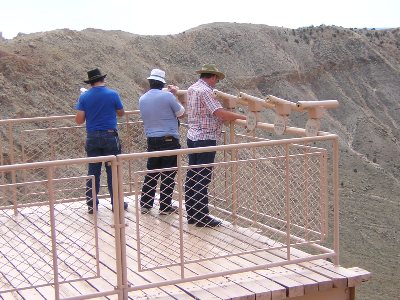
11.45am
We enter Coconino Forest. The land is heaped into hills and mountains and covered with Ponderosa pines. I’m reminded of an episode of Lassie.
12.30pm
On the way to our second stop, Slide Rock State Park, the landscape opens up in front of us and we’re twisting down into a deep red gully lush with pines. The rock faces tower above us and soon we’re following the creek along the valley floor. The scenery here is stunning, and too big to fit in a photograph. Nevertheless, I try.
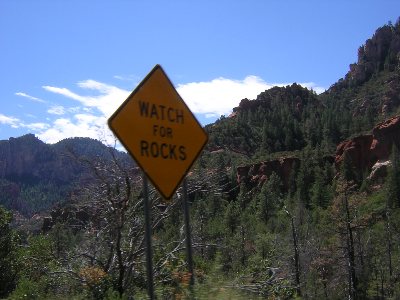
Slide Rock is a great leveller: people of all persuasions, classes, colours come to Slide Rock, change into bathing costumes and promptly fall flat on their arses on the slippery rocks. Girls shriek and men bellow as they splash through the icy water. Immediately I’m transformed into an excited ten-year-old slithering over the rocks and slooshing through the channels. After a couple of runs I convince Courtney to brave the frigid creek. At the end of our brief visit she’s made one run to my ten. Courtney has spent most of the time looking on like an indulgent mother. I don’t care. I just wish I had more playmates.
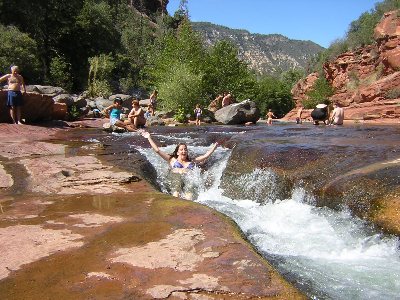
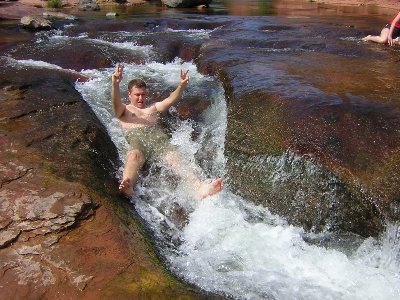
15.30pm
Leaving Slide Rock we pass through the town of Sedona, a clean little town full of southwestern architecture, tourists and bits of art set among the deep red rock. Some of the art is very good, such as the sculptures of horses made from rusty metal frameworks. It sparks off a memory of the town of Sefat in Israel, which is both an artists’ colony and a Kabbalah study centre. Sedona’s similar, but not so big on the Jewish mysticism.
15.55pm
We arrive at our third stop of the day, Montezuma’s Castle, which is a misnomer; the Aztec king Montezuma never travelled as far north as Arizona and it never was a castle. The name has stuck because it’s hard to imagine people driving out into the country to see a “cliff-side farmers’ dwelling.” Today there are no ladders leading up the cliff to the cliffside complex. It has been off-limits since the 1950’s when tourists with Kodak box brownies and flower-print shirts started doing irreparable damage to the fabric of the building.
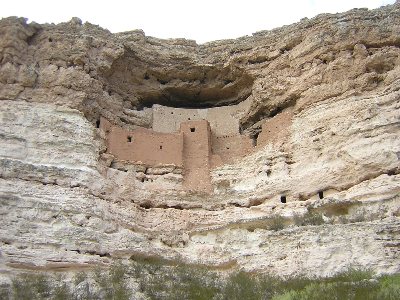
For someone like me, who was taught the myth that native Americans were tent-dwelling nomads, it’s startling to see, even from a distance. Certainly these people hadn’t either the technology or the wherewithal to erect buildings such as the cathedrals that were sprouting up across Europe at the same time, but the most advanced groups were far more advanced than “savages” we have been led to believe populated this continent.
17.45pm
Flagstaff, which in some kind of Shakespearian slip I keep referring to as Falstaff, is the nearest town to the Grand Canyon. There are Grand Canyon inns, motels and fried chicken drive-thrus — the words “Grand” and “Canyon” appear in about half of the town’s business names, which is amusing when you realise that Falstaff Flagstaff is eighty miles or an hour and a half’s drive away from the Grand Canyon.
19.10pm
Because of Arizona’s ridiculous refusal to acknowledge the existence of daylight savings time it’s nightfall when we reach the campground. Courtney and I read the Grand Canyon information leaflet by lamplight. The introductory article is some of the most pretentious, badly-written tosh we have ever read. “The Canyon is a gift that transcends what we experience,” it reads. Can anyone tell me what this could possibly mean? Is it good to be given presents you can’t understand?
